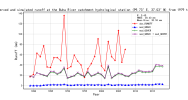Hello everyone,
I am currently using CLM5.0 to simulate watershed runoff on the Qinghai-Tibet Plateau in China and have encountered some issues. Hydrological stations are typically set up at the end of a river to observe the river's runoff . The outputs I have set in the model are QRUNOFF, QDRAI, QOVER, and QH2OSFC.
My questions are as follows:
1. I am unsure which variable or combination of variables corresponds to the observed data from the hydrological stations. I have referred to some literature, with some suggesting QOVER + QDRAI, and others suggesting QOVER + QDRAI + QDRAI_PERCH. Could you help me determine which is accurate? Thank you.
2. Using the QOVER + QDRAI method, I first obtained the observed annual runoff depth (mm) from the hydrological stations, then simulated and extracted QOVER, QDRAI, and QOVER + QDRAI at the coordinates of the hydrological stations. I found that while the fluctuations were reasonable, there was a significant numerical difference, mainly because QDRAI values were almost negligible. Why is this happening?
These issues are quite confusing to me, and I hope to get some help here. Thank you very much!
Best regards,
I am currently using CLM5.0 to simulate watershed runoff on the Qinghai-Tibet Plateau in China and have encountered some issues. Hydrological stations are typically set up at the end of a river to observe the river's runoff . The outputs I have set in the model are QRUNOFF, QDRAI, QOVER, and QH2OSFC.
My questions are as follows:
1. I am unsure which variable or combination of variables corresponds to the observed data from the hydrological stations. I have referred to some literature, with some suggesting QOVER + QDRAI, and others suggesting QOVER + QDRAI + QDRAI_PERCH. Could you help me determine which is accurate? Thank you.
2. Using the QOVER + QDRAI method, I first obtained the observed annual runoff depth (mm) from the hydrological stations, then simulated and extracted QOVER, QDRAI, and QOVER + QDRAI at the coordinates of the hydrological stations. I found that while the fluctuations were reasonable, there was a significant numerical difference, mainly because QDRAI values were almost negligible. Why is this happening?
These issues are quite confusing to me, and I hope to get some help here. Thank you very much!
Best regards,


